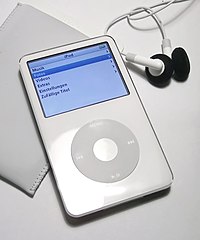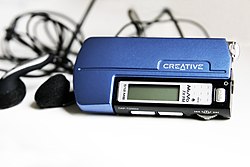Digital audio player



A digital audio player (DAP) is a device that stores, organizes and plays digital music files. It is more commonly referred to as an MP3 player (because of that format's ubiquity), but DAPs often play many additional file formats. Some formats are proprietary, such as Windows Media Audio (WMA), and, to a degree, Advanced Audio Coding (AAC) and MP3. Some of these formats also may incorporate restrictive digital rights management (DRM) technology, such as WMA DRM and Apple's "FairPlay", which are often part of certain paid download sites. Other formats are completely patent-free or otherwise open, such as Ogg Vorbis, FLAC, Speex (all part of the Ogg open multimedia project), and Module file formats.
There are three main types of digital audio players:
- MP3 CD Players - Devices that play CDs or downloaded music. Often, they can be used to play both audio CDs and homemade data CDs containing MP3 or other digital audio files.
- Flash-based Players - These are solid state devices that hold digital audio files on internal or external media, such as memory cards. Due to technological limitations, these are relatively low-storage devices, commercially ranging from 128MB to 8GB, such as the 2nd generation Ipod Nano, which can often be extended with additional memory. As they are solid state and do not have moving parts, they are very resilient. In effect, they do not suffer limitations that owners of Hard Drive-based players face, such as fears of dropping their player or fragmentation. Such players are generally integrated into USB keydrives.
- Hard Drive-based Players or Digital Jukeboxes - Devices that read digital audio files from a hard drive. These players have higher capacities, ranging from 1.5GB to 100GB, depending on the hard drive technology. At typical encoding rates, this means that thousands of songs — perhaps an entire music collection — can be stored in one MP3 player. Due to their capacity and physical size, image and video media support is becoming standard among Hard Drive-based players. The Apple iPod and Creative Zen are examples of popular digital jukeboxes.
History
The precursors to DAPs were portable CD players and MiniDisc players (neither being generally considered a "digital audio player"). Non-mechanical DAPs were introduced following the popularity of the precursors.
The first non-mechanical digital audio player in the world was created by SaeHan Information Systems in 1997. The MPMan F10 was later OEMed to the American market through Eiger Labs. The first non-mechanical digital audio player on the American market was the Eiger Labs MPMan F10, a 32MB portable that appeared in the summer of 1998. It was a very basic unit and wasn't user expandable, though owners could upgrade the memory to 64MB by sending the player back to Eiger Labs with a check for $69 + $7.95 shipping.
The second DAP (but widely considered the first mass market player) was the Rio PMP300 from Diamond Multimedia, introduced in September 1998. The Rio was a big success during the Christmas 1998 season as sales significantly exceeded expectations, spurring interest and investment in digital music. The Recording Industry Association of America soon filed a lawsuit alleging that the device abetted illegal copying of music, but Diamond won a legal victory on the shoulders of Sony Corp. v. Universal City Studios and digital audio players were ruled legal devices.
Other early DAPs includes Sensory Science's Rave MP2100, the I-Jam IJ-100, and the Creative Labs Nomad. These portables were small and light, but only held enough memory to hold around 7 to 20 songs at normal 128 kbit/s compression rates. They also used slower parallel port connections to transfer files from PC to player, necessary as most PCs then used the Windows 95 and NT operating systems, which did not support the then newer USB connections well enough to be considered for use. When in the year 2000 USB became more common, most players adopted the USB standard, with a few isolated models supporting the FireWire standard.
By the end of 1999, Compaq made a significant improvement in DAPs' space limitations by using a laptop hard drive for song storage rather than low-capacity flash memory. The Personal Jukebox (PJB-100), manufactured under license by HanGo Electronics, had 4.8GB of storage space, which held about 1200 songs (or 100 CDs, hence the name PJB-100), and was the beginning of what would be called the jukebox segment of digital audio players. This segment eventually became the dominant type of DAP.
Also, at the end of 1999, the first in-dash digital audio player appeared. The Empeg Car (renamed the Rio Car after it was acquired by SonicBLUE and added to its Rio line of MP3 products) offered players in several capacities ranging from 5GB to 28GB. The unit didn't catch on as SonicBLUE had hoped, however, and was discontinued in the autumn of 2001.
In 2000, iRiver released their first digital audio device.
The arrival of Apple Computer's iPod in 2001, combined with the iTunes software that all but created the legal-music-download business, greatly expanded the market. Since then, a number of new digital audio players became available each promising to be an "iPod Killer".
In 2004, Microsoft introduced their Digital Rights Management (DRM) technology under the PlaysForSure brand. This technology allows consumers to rent music from subscription music services such as Napster, Rhapsody, and Yahoo Music Unlimited and transfer it to their compatible digital audio players.
In 2006, MSI developed and showcased the first solar powered player, the MSI MEGA 540, at CeBIT in Hanover, Germany.[1]
Equipment
Generally speaking, digital audio players are portable, employing internal or replaceable batteries and headphones, although users often connect players to car and home stereos. Some DAPs also include FM radio tuners and/or microphones for voice recording. Many players can encode audio directly to MP3 or other digital audio formats directly from a line in audio signal.
Recently Flash digital audio players have even been incorporated into sunglasses, as demonstrated by the Oakley's "thump" model.
A number of manufacturers now produce Network MP3 players. These tend to be non-portable devices which have no storage of their own. Instead, they connect to a home ethernet network, and receive a digital audio stream from some computer on the network. They are designed to connect to a home stereo, and are operated with a remote control. Slim Devices, Roku, and cd3o each produce a Network MP3 device.
Modular keydrive players are composed of two detachable parts: the head (or reader/writer) and the body (the memory). They can be independently obtained and upgraded (one can change the head or the body; i.e. to add more memory).
Usage/Usability
As digital audio players have spread, new uses have been found for them. This includes podcasting, in which radio-like programs, or even TV-like video feeds, are automatically downloaded into the device to be played at the owner's convenience. Even a low-capacity digital audio player can store several hours of podcasts.
Audio acquisition
Most, if not all, digital audio players can play music that has been ripped from Compact Discs via computer. In addition to ripped CD tracks, many digital audio players can accept downloaded music from online music stores. However, such stores often use proprietary formats and DRM, which means that the tracks can only be played on suitably licensed and restricted devices. The main formats in use are WMA/PlaysForSure from Microsoft, AAC/FairPlay from Apple and ATRAC from Sony, all of which are mutually incompatible.
A huge amount of legal, freely downloadable Module file (.MOD) music is available on the Internet from sites such as The MOD Archive [2]. Most MOD files are composed by individuals who allow them to be freely distributed, unlike MP3 files ripped from commercial CD tracks. While today's digital audio players generally do not support MOD files directly, progress is being made on that front with projects such as the TRAXMOD [3] digital audio player. For everyone else, it is possible to convert MOD music into MP3 format using software such as Winamp.
Compared to other music-listening media
MP3 players are superior in many ways, and the reasons will be described in these sections:
Compact discs
- higher data storage density and smaller physical size (the smallest digital audio player is about 1/20th the size of a personal cd player).
- skip free (solid state)
- consumes less power
- even though they are more expensive than compact disc players, prices are expected to go down substantially during the next ten years. However, MP3 players are cheaper than CD players with advanced error-correction and anti-shock features.
- more logical random shuffling
- more user-friendly song-selection interface (on CDs, you have to memorize track numbers, but on some MP3 players, you see song title, artist and album text on a list)
- with the advent of higher storage capacity, run with more time than a CD changer of CDs. Along with a bigger library in a smaller form factor.
Radio stations
- No commercials or DJs talking between songs.
- No interference
- No loss of signal
- No unwanted songs
- Note: many descriptions from Compact disc apply here too.
- No fragile tape
- No moving parts
This list is incomplete; you can help by adding missing items. |
Major brands of digital audio players
A * denotes a digital audio player that requires unique software to load content onto.

- Archos
- Creative NOMAD/Creative Zen*/MuVo line from Creative Technology
- Gigabeat* from Toshiba
- iAudio from Cowon
- iPod* from Apple Computer
- iriver
- Q-Be
- Sansa from Sandisk
- Walkman/PlayStation Portable from Sony
- Yepp from Samsung
- Zune* from Microsoft
- MPIO
This list is incomplete; you can help by adding missing items. |
See also
- Internet radio device
- Audio player (software)
- Portable media player (PMP)
- Comparison of portable media players
- Podcasting
External links
This page or section may contain link spam masquerading as content. |
Comparison engines
- Hardware Duel - Comparison website for MP3 players.
- CNET Asia Music & Play - Comprehensive search comparison engine for digital audio player reviews, specifications, price and pictures.
News and reviews
- D.A.P review - Up-to-date news, reviews, for digital audio players, pmp and anything related.
- AnythingButiPod - News and Reviews of iPod Alternatives
- The MP3 Players - Reviews on MP3 players and related news
- CNET Asia Music & Play - News, reviews, features and shootouts for digital audio players in Asia.
- Gadget Review - Reviews, pros and cons for digital audio players
- BooksAlley - Best MP3 players for Audio Books
Other links
- Collecting MP3 Portables -- Part I and Part II- Richard Menta's two-part article covers the first digital audio players on the market with pictures of each player.
